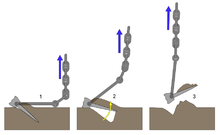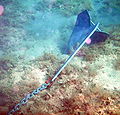Patent anchor
A patent anchor is an anchor that derives its holding power from digging into the ground when pulled almost horizontally. They always belong to the stickless anchors. This means that at the upper end of the shaft, below the ring, they do not have a stick that goes across the flukes.
The patent anchor (Hall anchor) shown in the pictures below on the left has two movable flukes , which dig into the seabed by pulling horizontally and by their own weight, thus giving the anchor chain a hold. The flukes incline here by up to 45 degrees against the shaft. In order to ensure horizontal pull, the chain length must correspond to about three to five times the water depth when anchoring, depending on the wind and sea conditions. If the anchor is torn into the vertical while catching up , the flukes are released from the ground, so that the anchor breaks.
Patent anchors are the most widely used anchors for seagoing ships today , since weight anchors , which derive their holding force essentially from their own weight, are no longer sufficient for today's ship sizes.
This type of anchor has also largely established itself in inland shipping . Patent anchors lie flat when they are pulled up and are stowed in the anchor pocket or the hawk tube in such a way that no part protrudes beyond the ship's side. This is required by the traffic regulations. A complicated anchor gear with an anchor crane, called anchor davit, is also superfluous.
The construction of the patent anchors is partly protected by patents. The manufacturer then often gives the anchor in question.
A selection of common patent anchors are Danforth anchors, clip anchors, HaDu anchors, D'Hone anchors, Hall anchors, pool anchors (Hiholding pool anchors), Heuss anchors, ploughshare anchors.
literature
- Rolf Dreyer: Sportküstenschifferschein and Sportbootführerschein See , Delius Klasing Verlag, 5th edition, 2001, ISBN 3-7688-1137-9
- Rhine Shipping Police Ordinance (PDF file; 3.12 MB), § 1.12 RheinSchPV




